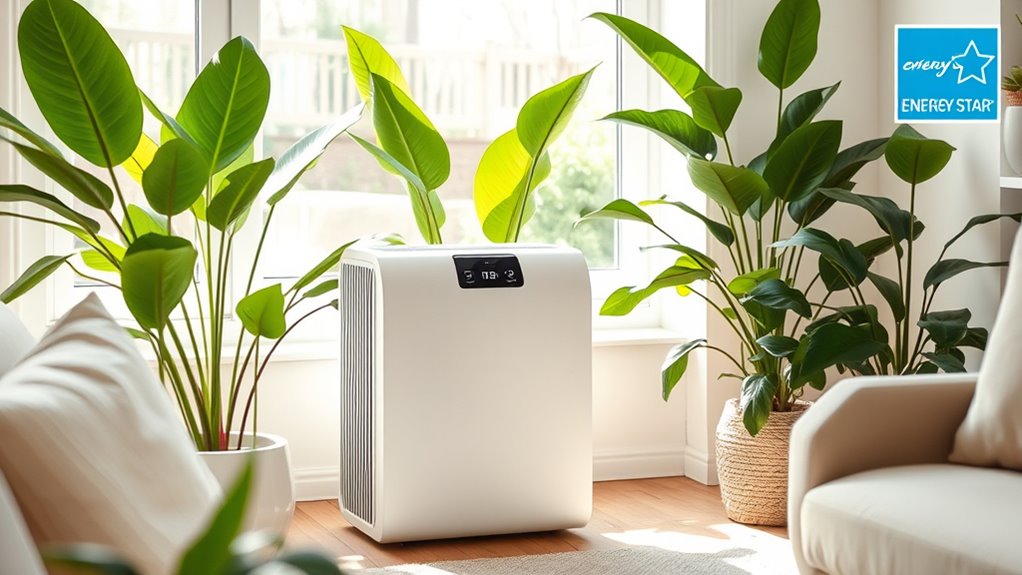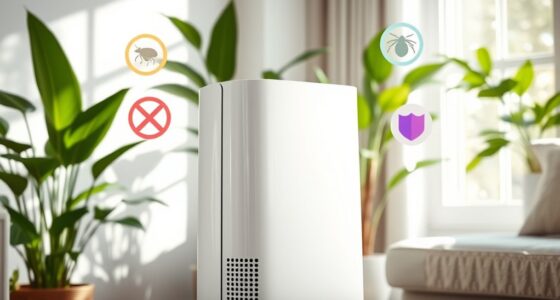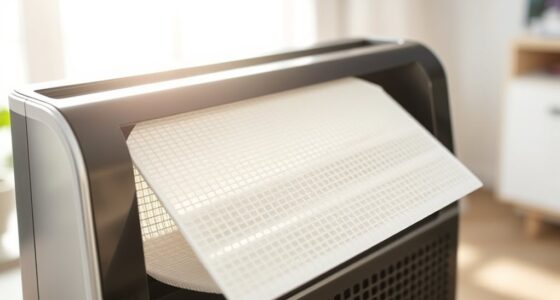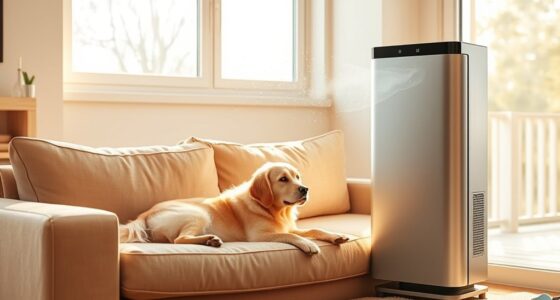When choosing an ENERGY STAR-rated air purifier, look for models with real-time air quality sensors, low power consumption, and energy-saving modes like Eco or Sleep. Make sure it’s properly sized for your room’s square footage and has a high CADR rating for effective cleaning. Quiet operation, easy filter access, and eco-friendly features such as solar compatibility can boost efficiency. Keep these tips in mind to find the best model and discover more helpful insights ahead.
Key Takeaways
- Ensure the purifier is ENERGY STAR certified to guarantee compliance with energy performance standards and rigorous testing.
- Look for models with energy-saving modes like Auto, Sleep, or Eco to reduce power consumption during operation.
- Check the CADR rating to match the purifier’s coverage area with your room size for optimal efficiency.
- Choose units with eco-friendly, washable, or reusable filters to minimize waste and maintenance costs.
- Consider smart features such as remote control, real-time energy monitoring, and auto-adjustment based on air quality.
Understanding the ENERGY STAR Certification
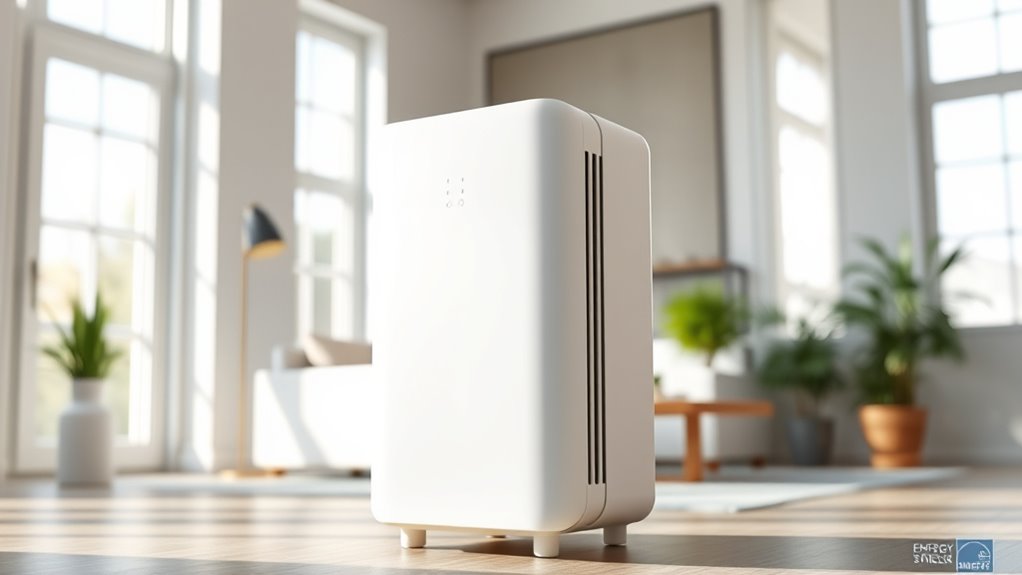
Understanding the ENERGY STAR certification is essential when choosing energy-efficient air purifiers because it signifies that the product meets strict energy performance standards set by the U.S. Environmental Protection Agency. This certification process evaluates how well an air purifier improves air quality while using less energy, aligning with high air quality standards. When a product earns ENERGY STAR, it has undergone rigorous testing to verify its efficiency and performance. This means you can trust that certified models deliver cleaner air without consuming excessive power. Additionally, ENERGY STAR models often incorporate energy-saving features that further reduce electricity consumption. By choosing ENERGY STAR-certified air purifiers, you ensure you’re investing in appliances that meet strict environmental and energy guidelines, helping you reduce energy bills and minimize your carbon footprint while maintaining healthy indoor air quality.
Key Features of Energy-Efficient Air Purifiers

Energy-efficient air purifiers come with features that help you conserve power and reduce environmental impact. You’ll find energy saving modes and low power consumption designs that make a difference during daily use. Additionally, eco-friendly filters ensure cleaner air without harming the planet. For added convenience, some models include smart connectivity options that allow remote monitoring and control to optimize energy use.
Energy Saving Modes
Many energy-efficient air purifiers come equipped with specialized energy-saving modes designed to reduce power consumption without sacrificing performance. These modes adjust fan speed based on air quality, ensuring you get ideal purification while conserving energy. When air quality improves, the purifier lowers fan speed, saving power and reducing noise. Conversely, during poor air quality, the device increases fan speed to filter pollutants effectively. Here’s a quick overview:
| Mode | Function | Benefit |
|---|---|---|
| Auto Mode | Adjusts fan speed based on air quality | Saves energy, maintains air quality |
| Sleep Mode | Low fan speed for quiet operation | Reduces power use and noise |
| Eco Mode | Optimizes fan speed for efficiency | Minimizes energy consumption |
Additionally, many models incorporate smart features that help monitor and manage energy use more effectively.
Low Power Consumption
Low power consumption is a defining feature of modern energy-efficient air purifiers, helping you save on electricity bills while maintaining ideal air quality. These models often include air quality sensors that monitor pollutants in real-time, adjusting their operation to optimize energy use. This means the purifier runs only as hard as needed, reducing unnecessary power draw. Additionally, many energy-efficient purifiers feature portable designs, making it easy to move them between rooms without high energy costs. High refresh rates and the ability to adapt to real-time air quality conditions further enhance their efficiency. By choosing a model with low power consumption, you guarantee continuous air purification without substantially increasing your energy bills. This approach not only benefits your wallet but also supports a greener lifestyle, all while keeping your indoor air fresh and healthy.
Eco-Friendly Filters
Eco-friendly filters are an essential component of energy-efficient air purifiers because they help reduce waste and minimize environmental impact. These filters effectively improve air quality by capturing indoor pollutants like dust, pollen, pet dander, and volatile organic compounds. Look for models with washable or reusable filters, which decrease landfill waste and lower replacement costs. High-quality eco-friendly filters use sustainable materials and advanced filtration technology, ensuring you breathe cleaner air without harming the environment. Choosing an air purifier with such filters not only supports sustainability but also enhances indoor air quality. Regular maintenance of these filters maximizes their lifespan and efficiency, keeping your indoor environment healthier while reducing your ecological footprint. Additionally, raw food diets can be a natural way to promote overall health and wellness, emphasizing fresh and unprocessed ingredients.
Types of Air Purification Technologies to Consider
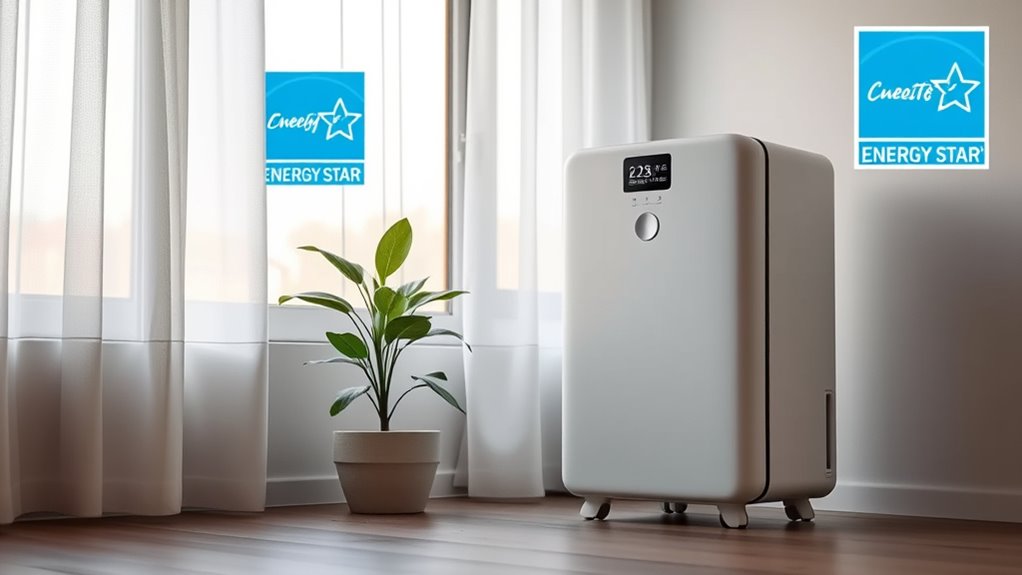
When choosing an energy-efficient air purifier, understanding the different technologies it employs can help you make an informed decision. HEPA filters are a popular choice, capturing 99.97% of particles as small as 0.3 microns, including dust, pollen, and pet dander. Activated carbon filters are excellent for removing odors, volatile organic compounds (VOCs), and gases. Some purifiers combine these technologies to provide all-encompassing air cleaning. Other options include electrostatic precipitators, which use electrical charges to trap particles, and UV-C light, which kills bacteria and viruses. Each technology has its strengths, so consider your specific needs. Remember, the most energy-efficient models often use a combination of these technologies to maximize performance without increasing power consumption. Additionally, understanding the science of sound healing and vibration can inspire innovative features in air purifiers, such as sound-based mechanisms that promote relaxation and health benefits.
Importance of Proper Room Size and Coverage
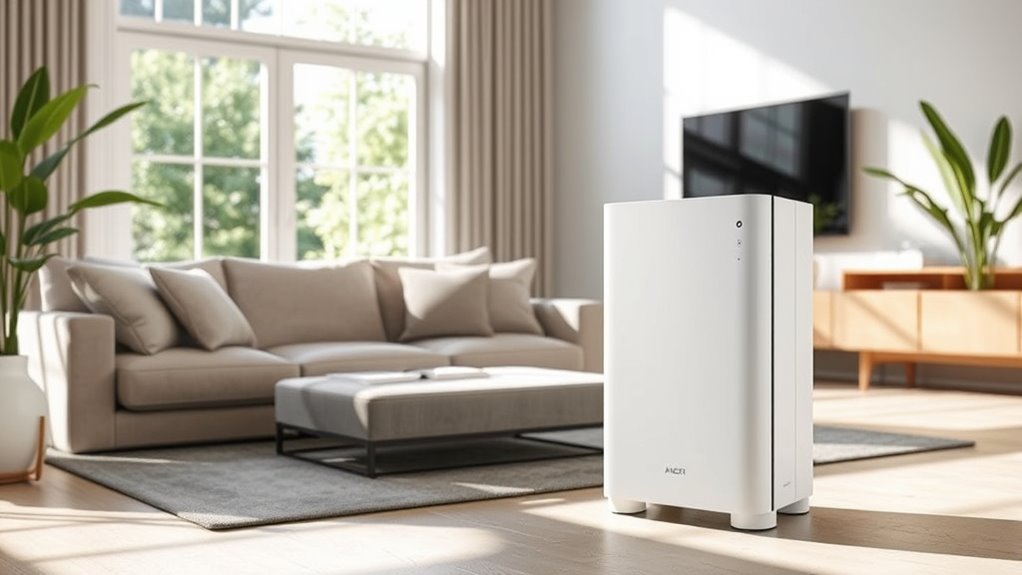
Choosing the right air purifier depends on your room size, so make sure to match the unit’s coverage to your space. Check the CADR ratings to see how effectively it cleans the air in rooms similar to yours. Avoid oversized units, as they can waste energy without providing extra benefits. Additionally, selecting a model with appropriate filter replacement indicators ensures ongoing efficiency and optimal performance.
Match Room Dimensions
Selecting an air purifier that matches your room’s size is essential for peak performance. An appropriately sized unit ensures effective air cleaning without wasting energy. To do this, consider these factors:
- Check the room’s dimensions and match them to the purifier’s coverage area.
- Look for models with advanced air quality sensors that automatically adjust fan speed for *maximum* efficiency.
- Choose units compatible with smart home integration, allowing you to monitor and control air quality remotely.
- Consider energy-efficient ENERGY STAR models that are designed to operate with lower power consumption and meet strict efficiency standards.
Properly sized purifiers prevent overworking and save energy, making them more cost-effective. They also maintain consistent air quality by adjusting output based on real-time data. By matching your room size and leveraging smart features, you ensure your air purifier operates efficiently while delivering clean, healthy air.
Check CADR Ratings
Checking the CADR (Clean Air Delivery Rate) ratings of an air purifier is crucial to guarantee it can effectively clean the air in your specific space. Higher CADR ratings mean better airflow and filtration efficiency, ensuring cleaner air faster. To maximize energy efficiency, choose a model with a CADR suited to your room size—overpowered units waste energy, while undersized ones struggle. Use this guide:
| Room Size (sq ft) | Recommended CADR |
|---|---|
| Up to 300 | 100-150 |
| 300-600 | 150-250 |
| 600-900 | 250-350 |
| 900-1200 | 350-450 |
| Over 1200 | 450+ |
Matching your room size with the right CADR ensures energy-efficient air purification without unnecessary power consumption. Additionally, proper room size matching helps prevent the unit from working harder than necessary, conserving energy and extending the lifespan of your purifier.
Avoid Oversized Units
Using an oversized air purifier for your room can waste energy and reduce efficiency because it runs at higher power levels than necessary. Choosing a unit that matches your room size guarantees *ideal* performance and saves energy. An oversized purifier might also impact aesthetics, making it look bulky or out of place. To make the best choice, consider:
- Checking the room size the model is designed for
- Comparing brand reputations for reliability and efficiency
- Ensuring the unit fits your space without sacrificing style
- Proper sizing helps prevent inefficient operation and ensures optimal air cleaning performance. Proper sizing helps you avoid unnecessary energy use and maintains a cleaner aesthetic. An ENERGY STAR model with appropriate coverage will perform better, last longer, and support your eco-friendly goals—all while keeping your space stylish and functional.
Noise Levels and Energy Consumption
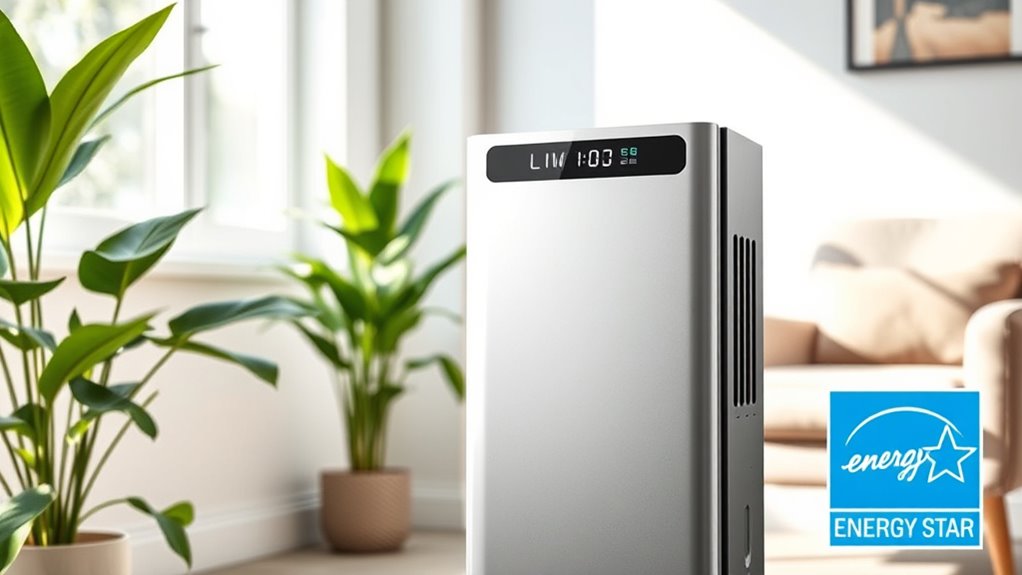
While energy-efficient air purifiers aim to reduce power consumption, their noise levels can vary considerably, impacting user comfort. To keep noise minimal, look for models with good sound insulation and vibration reduction features. Sound insulation helps prevent the transfer of noise through walls and surfaces, making the purifier less disruptive. Vibration reduction minimizes motor and fan vibrations that can amplify noise. ENERGY STAR models often incorporate these design elements for quieter operation. Keep in mind that lower energy consumption doesn’t necessarily mean louder operation, so check decibel ratings and user reviews. Choosing a unit with effective sound insulation and vibration reduction guarantees you enjoy clean air without sacrificing peace and quiet. This balance enhances both efficiency and comfort in your living space. Additionally, some models may feature silly tantrums or unexpected noises during operation, so reviewing user feedback can help identify the quietest options.
Maintenance and Filter Replacement Efficiency
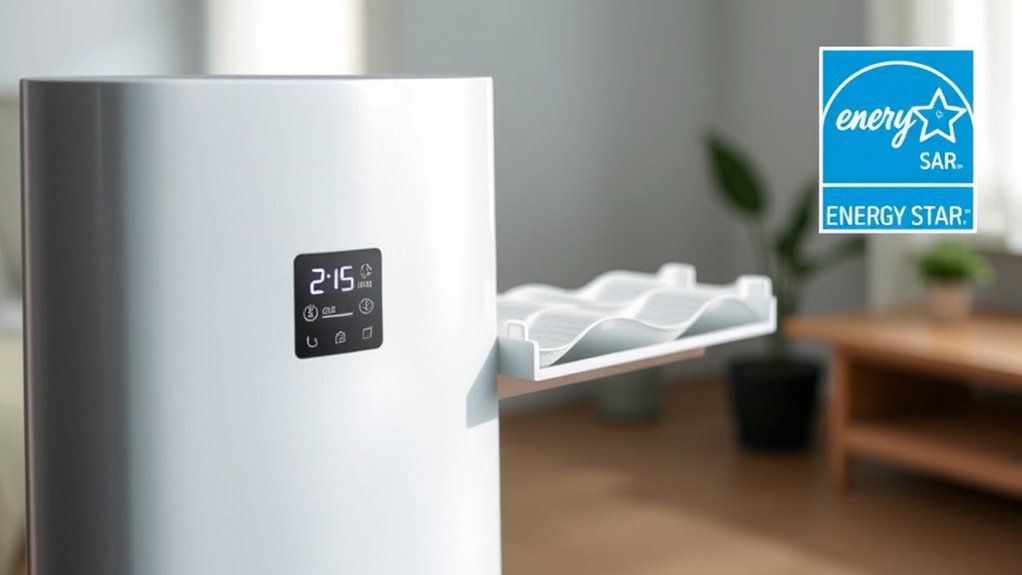
Efficient maintenance and easy filter replacement are essential for ensuring your air purifier operates at peak performance. Regularly replacing filters keeps the device running smoothly and maintains air quality. To optimize filter replacement and maintenance, consider these tips:
Regular filter upkeep ensures your air purifier runs efficiently and maintains optimal air quality.
- Follow manufacturer guidelines for filter change intervals to prevent strain on the motor.
- Keep filters clean by vacuuming or washing, if applicable, to extend their lifespan.
- Record maintenance dates to stay on schedule and avoid neglect.
- Choose models with easy-to-access filters to simplify the replacement process and reduce downtime.
Additional Eco-Friendly Features and Settings

Many air purifiers now include eco-friendly features and settings designed to reduce energy consumption and environmental impact. Solar integration allows your purifier to harness renewable energy, decreasing reliance on grid power and lowering your carbon footprint. Look for models with smart home compatibility, enabling you to control and schedule your purifier remotely, optimizing energy use when you’re away or asleep. Some units offer eco-mode settings that automatically adjust fan speeds based on air quality, conserving power during periods of low pollution. These features not only help minimize energy waste but also promote a more sustainable lifestyle. By choosing models with solar integration and smart home compatibility, you enhance both convenience and eco-friendliness in maintaining clean indoor air. Additionally, advanced monitoring systems can provide real-time feedback on energy consumption, helping you make more informed choices to further improve efficiency.
Comparing Models and Reading User Reviews
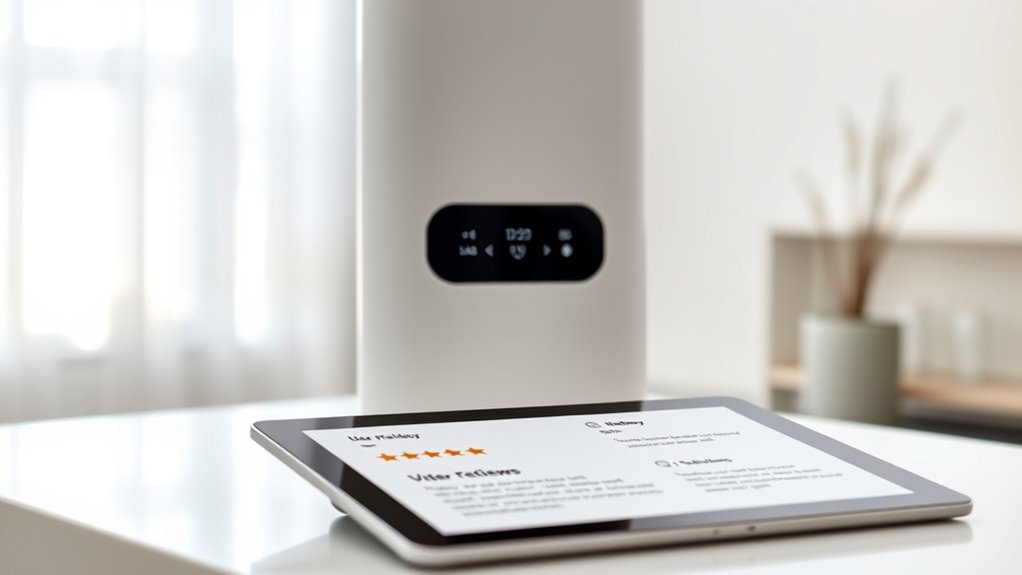
When choosing an air purifier, comparing different models and reading user reviews can provide valuable insights that specifications alone might overlook. User reviews reveal how well a purifier meets air quality standards in real homes, often highlighting issues not listed in specs. To make an informed choice, consider:
- How users rate the purifier’s effectiveness in improving air quality.
- Whether the model’s air purifier pricing fits your budget while delivering reliable performance.
- Real-world durability and maintenance experiences that influence long-term value.
- Evaluating Kia Tuning options can also serve as a metaphor for customizing your air purifier to better suit your specific needs.
These factors help you identify models that balance energy efficiency with performance. By comparing features and reading reviews, you ensure your investment aligns with your air quality needs and eco-friendly goals, avoiding models that fall short despite their ENERGY STAR label.
Frequently Asked Questions
How Can I Verify if an Air Purifier Truly Meets ENERGY STAR Standards?
To verify if an air purifier truly meets ENERGY STAR standards, check for the ENERGY STAR Certification label on the product. You can also look up the model on the ENERGY STAR website for Performance Verification details. This guarantees the purifier has been tested and meets energy efficiency requirements. Remember, certified models help you save energy and reduce costs while maintaining effective air cleaning.
Do Energy-Efficient Models Cost More Initially Than Standard Air Purifiers?
While the initial investment in energy-efficient air purifiers might seem a touch higher, you’re often rewarded with long-term savings through lower energy bills. The cost comparison usually balances out over time, especially with models that include robust warranty coverage. Plus, an ENERGY STAR model offers added peace of mind, ensuring you’re investing in a device that’s both eco-friendly and reliable for years to come.
Are There Specific Brands Known for Reliable ENERGY STAR Air Purifiers?
When choosing an ENERGY STAR air purifier, you wonder if certain brands are more reliable. Based on brand reputation and user reviews, brands like Winix, Honeywell, and Blueair stand out for their quality and efficiency. You should look for trusted names, positive feedback, and proven performance. This way, you guarantee you’re investing in a model that’s durable, effective, and environmentally friendly, giving you peace of mind in your air quality.
How Often Should Filters Be Replaced in Energy-Efficient Air Purifiers?
Did you know regular filter replacement can boost your air purifier’s efficiency by up to 15%? For ideal performance, you should check your filter every 3-6 months, depending on usage and air quality. Follow maintenance tips like keeping the unit clean and replacing filters promptly to guarantee fresh, healthy air. Staying on top of filter replacement frequency helps your ENERGY STAR model operate at peak efficiency and longevity.
Can Energy-Efficient Air Purifiers Effectively Remove All Indoor Pollutants?
You might wonder if energy-efficient air purifiers can fully clean your indoor air. While they do a good job at pollutant removal, no purifier can eliminate all indoor pollutants completely. They improve air quality by removing common allergens, dust, and some airborne toxins. To maximize effectiveness, choose a model with appropriate filters and proper coverage for your space. Remember, regular maintenance also plays a key role in maintaining ideal air quality.
Conclusion
Choosing an ENERGY STAR air purifier can cut your energy use by up to 30%, saving you money and reducing your environmental impact. Look for models with efficient filters, appropriate coverage, and eco-friendly features. Reading user reviews helps you find reliable options. By selecting an energy-efficient purifier, you’re not only improving indoor air quality but also making a smart, eco-conscious choice that benefits your wallet and the planet.
